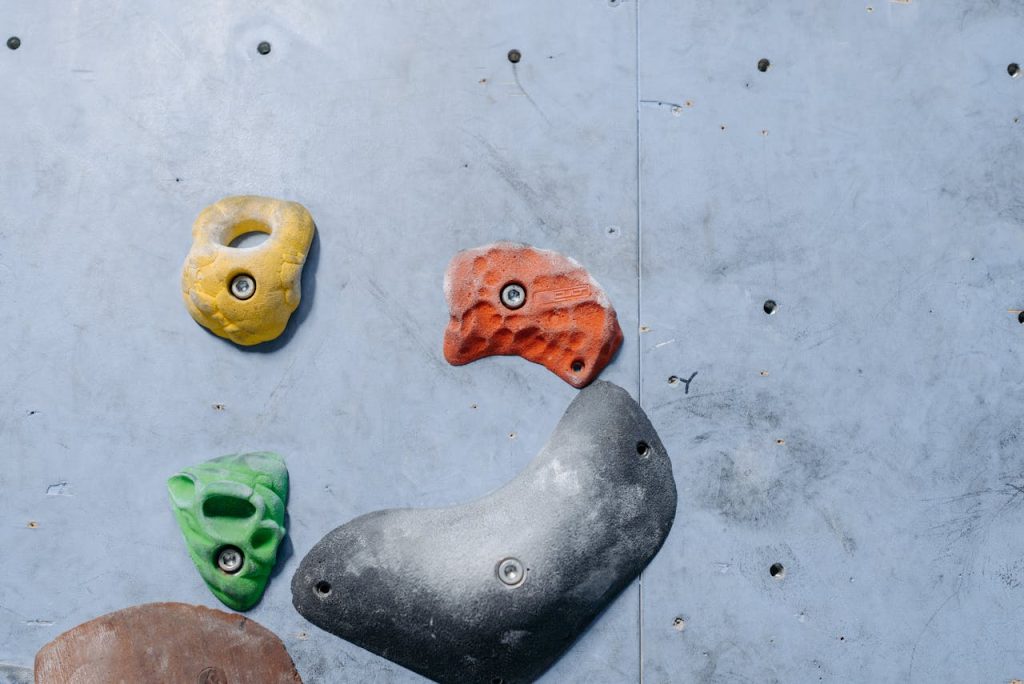The types of climbing holds you’ll find in a gym are inspired by natural features found in rock. Running water, wind erosion, rock fall, etc., have shaped natural climbing holds for millions of years!
If you’re new to climbing, you might get confused when you hear somebody talk about a sloper or a jug. Not after this! Understanding the types of climbing holds and how to use them will improve your climbing and help you talk about beta with any climber.
What Are Climbing Holds?
Climbing holds are the protruding plastic that is screwed onto a climbing wall. They come in various shapes and sizes, and it takes some practice to grab them efficiently. If you frequent a bouldering wall, you can touch tons of holds from the ground and work on what it takes to use them.
You’ll find handholds and footholds at any climbing gym. While handholds can be used for your feet, footholds are designed only to be stepped on. Footholds are easy to notice because they’re typically smaller and would be heinous to grab. Larger footholds can help you up the wall, but you’ll often want to stick to just grabbing handholds.

What Kind of Climbing Holds Are There?
Some handholds are apparent; they can have a rounded edge and be comfortable to grab, or they can be sharp and tiny or monstrous with no natural depression to grip.
Usually, the more complex the handhold, the harder the grade of a climb. Below is a list of every type of climbing hold you’ll find and how to use it the next time you’re at the gym.
Crimp – Small edges that only fit your fingertips.
How to use: Fit as much of your fingers on the hold as possible and pull down.
– Open-Hand Crimp: When your fingertips are on a crimp, and your hand is below the hold.
– Half-Crimp: When your fingertips are on a crimp, and your knuckles are bent around 90°.
– Full Crimp: When you’re half-crimping, bring your thumb over the top of your pointer finger.
Avoid full crimping at your max until your fingers have strengthened. Full crimping is a major cause of finger injuries in climbing.
Cracks – The negative space on a climbing wall.
How to use: Try to fill the space with whatever limb you jam into it. That includes hand jams, fist jams, finger locks, foot jams, etc.
(Crack climbing is a discipline itself and requires specific techniques to learn)
Flake – Thin, partly detached piece of rock you can grab from any exposed side. You’ll likely only find these outside, but they’re essential to know.
How to use: First, check if it’s safe by banging on it and listening to how hollow it sounds. If it’s good, a flake can be used as a jug!
Jug – Large, in-cut hold that can be grabbed with all your fingers. You’ll find them to be the friendliest type of hold and ones on the most manageable climbs.
How to use: Your fingers should curl over the hold as if you’re trying to pull the hold off the wall.
Ledge – Large hold like a Jug, but flat.
How to use: Stay under the ledge to use it until you must move for the next hold. The higher you move your body on a ledge, the harder they are to hold.
Pinch – A rectangle-looking hold that can be wide or narrow.
How to use: Wrap your fingers around one side and thumb around the other and try to squeeze the hold together.
Pockets – A hole that you stick your fingers into. It can be two or three-fingered and can be shallow or deep.
(Mono) – This is a pocket that only a single finger can fit.)
How to use: Fit as many fingers as you can. And treat these like a jug if they’re deep or a crimp if they’re shallow.
Sloper – Rounded blobs.
How to use: Try to get as much of your hand on it as possible and pull away from the direction they’re facing. Slopers require friction, so you want to grab as much surface area as possible.
Undercling – Any climbing hold but is turned upside down!
Side Pull – Also, any climbing hold but is turned sideways!
Practice using every climb hold that you can find! Many people have a particular type of hold they prefer and aren’t as strong with other holds. If you can develop your strength in each kind of hold, you’ll start as a well-rounded climber!

Recent Comments